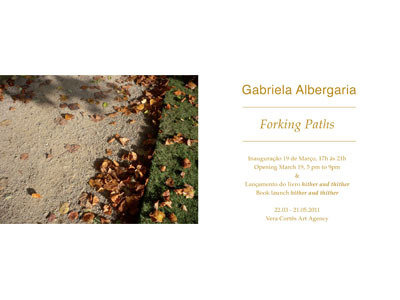Gabriela Albergaria
dal 21/3/2011 al 20/5/2011
Segnalato da
21/3/2011
Gabriela Albergaria
Vera Cortes Art Agency, Lisboa
Like Borges's story The Garden of Forking Paths, Albergaria's recent work is all about potential and the experience of process. At its heart lies a riddle whose theme is time, for just as it folds back on itself in infinite regression so it bifurcates toward innumerable futures. Each piece represents a set configuration of effects that contains within it the germ of infinitude.

A path divided
The Argentine writer and poet Jorge Luis Borges wrote a short story in 1941 called The
Garden of Forking Paths in which he suggested that art and life could be read in manifold
ways. For Borges, the world was a labyrinthine maze where all possible outcomes of an event
might occur simultaneously, with each one leading to a further proliferation of possibilities.
Like Borges’s story, Gabriela Albergaria’s recent work is all about potential and the
experience of process. At its heart lies a riddle whose theme is time, for just as it folds back
on itself in infinite regression so it bifurcates toward innumerable futures. Each piece
represents a set configuration of effects - a precise relationship between forms, an exact
combination of colours, a particular detail of light and shade - that contains within it the germ
of infinitude.
The photographs, drawings and texts in Forking Paths derive from the artist’s residency at the
University of Oxford Botanic Garden in 2009-10. The Botanic Garden has long been a source
of inspiration for artists and writers. Since it was founded in 1621 as a facility ‘whereby
learning might be improved and promoted’ it has played a role in the teaching of the
University’s students. Beside this traditional function, visitors are encouraged to engage with
plants in all their diversity, but many of them come expressly to see the tree collection, which
plays a major role in creating the Botanic Garden’s unique sense of place.
During the course of her time in Oxford, Albergaria produced a publication called hither and
thither, which falls somewhere between a scholarly guide to the tree collection and an artist’s
book. The images in the book were generated while Albergaria walked around the Botanic
Garden, familiarising herself with some of its more noteworthy specimens, and the publication
represents an attempt to chart the arboreal identity of the site in all its visual, historical and
biological complexity.
The exhibits in Forking Paths offer up an equally considered, but more imaginative mapping,
in which attention, fiction and choreography all have their part to play. The show begins with a
drawn text that reads: ‘Three-dimension space means choosing/ an ordered triplet of lines
(axes),/ any two of them being perpendicular/ for all three axes/ a single unit of length/ and an
orientation for each axis’ The space of the installation is emphatically architectonic, but the
fact that the introductory text is physically and graphically fragmented suggests that any
definition of space must be regarded as elastic over time. This acknowledgement of the fluid
character of space-time creates an establishing context within which all of the work on display
should be viewed.
Following on from the introductory text is a show of conjoined photographs and drawings of
tree trunks in and panoramas of the Botanic Garden, alongside stand-alone drawings of
surfaces, texts and colour bars. These pieces reflect the hues of nature and flirt with the
notion of illustration. However, because they were produced in Albergaria’s studios in Lisbon
and New York, they rely for their creation on the act of recall, which is always imperfect. For
the artist it is the memory errors that creep in at such moments that distinguish the work from
illustration.
Albergaria’s art constructs bridges between media and addresses itself to Borgesian
dichotomies and crossovers. Her installation marries the phenomenological concerns of
primary experience and authenticity with a structuralist focus on language, description and
binary opposition. She uses photography as a tactical point of departure for her drawings and
as a strategic tool for defining her position in relation to other art practices; seen together her
photographs and drawings summon up a specific experience of place, which is
simultaneously underlined and undermined.
The conjoined photographs and drawings are printed on textured paper and both they and the
stand-alone drawings reveal a sustained interest in all-over pattern-making. The images are
restrained yet they retain what can only be described as a romantic attachment to their
subject, and Forking Paths provides us with an opportunity to consider the extent to which the
artist has succeeded in embracing and objectifying her twin passions for nature and culture.
Paul Bonaventura - Senior Research Fellow in Fine Art Studies University of Oxford
Opening 22 March 2011
Vera Cortes Art Agency
v. 24 De Julho, 54 - Lisboa
Hours: Tuesday to Saturday from 2 p.m to 7 p.m
And by appointmen



